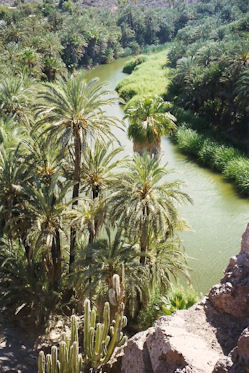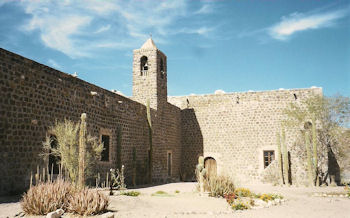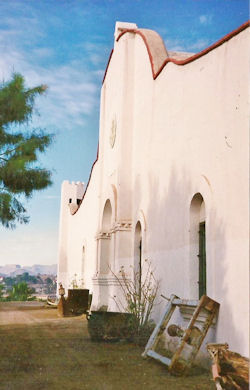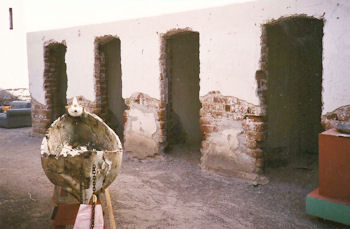 |  |
By Greg Niemann

Baja’s languid picturesque village of Mulegé has endured an interesting life. The lush valley town straddles a fresh water river that empties into a beautiful estuary on its way to the Sea of Cortez. Tropical Mulegé has long attracted visitors, from Indians to padres, to Americans who were repelled, and to Americans who were welcomed.
The name Mulegé is derived from the Cochimi language meaning "Large ravine of the white mouth." In 1705 the popular Padre Juan de Ugarte brought Padre Juan Maria Basaldua to the area to establish a mission they called Santa Rosalia de Mulegé. The beautiful stone building that replaced the original mission is still standing on a rocky promontory overlooking the river.
Fourteen years later, Ugarte built the first boat ever constructed in the Californias in the Mulegé estuary. That ship, named Triunfo de la Cruz, was the finest sailing ship in California at the time and was used many times crossing the Sea of Cortez.
The settlement was flooded in 1770 but the town was rebuilt and restored to normal shortly thereafter. Over two centuries later storms and hurricanes continue to cause problems. For example, Hurricane Jimena in September 2009 destroyed much of the town, especially the low-lying areas along the river. And just like the previous tragedies, the residents regrouped and rebuilt.
A lot of gringos are unaware that the official name of the town is "Heroica Mulegé," honoring the residents of Mulegẻ for their part in the Mexican-American War’s 1847 Battle of Mulegé. The locals from Mulegé and surrounding settlements rallied behind Captain Manuel Pineda to repel the American naval advance.
It was an important battle that galvanized the Mexicans and taught them that the American military was not invincible, and Mulegé was not occupied by the invaders. Even today, on official papers and letters of the Government of Baja California Sur you will find the title "Heroica Mulegé."

Most interesting chapter
But perhaps the most interesting chapter in Mulegé history was the territorial prison that was erected on the hill above town in 1907. This prison was different. The inmates were allowed to leave each morning to work in town as long as they returned when the horn was sounded each afternoon.
While locally it had many nicknames, including "The University," officially it was the Territorial Prison of Baja California del Sur. Some visitors remember up to 30 and 40 prisoners.
The doors were open during the day. The prisoners would go out to earn minimum local wages either pruning palms or fishing, or other work. For a while during the 1950s, some worked on the construction of a hospital. At 6 p.m. the caretaker would blast a loud conch shell horn. The prisoners and guards would then drift in from all directions. Roll was called, the prisoners marched into prison and doors were closed. It was said that they were not allowed to dance or drink, but they could go to a dance if they stood on the sidelines to watch.

Author O. W. Timberman (Mexico’s Diamond in the Rough, Westernlore Press, 1959) noted:
"On top of this hill was the prison, surrounded by a high wall with sentry boxes placed at the corners. We were allowed to go as far as the high iron doors, where we passed out cigarettes and candy to the inmates, totaling four, who were locked inside. I bought, from one of them, a hat band he had made of braided horse hair. From the looks of the interior that we could see from this gate, the quarters could not be called luxurious. The prisoners' blankets, which were all the bed they had, were rolled on the bare ground, and the place was far from sanitary.
"Any other prisoners they might have had were probably off in the town at some form of work, for it was our understanding that the honor system was used here, and those who were in good grace were allowed to work in the date groves and vegetable gardens close by—the only restrictions being that they could not enter places where intoxicating liquors were sold, and they had to be back at the prison at a specified time each evening to answer roll call. I could not help but wonder how an escaped prisoner could go very far in this wasteland and survive. Considering the great distances between habitations and the frugal water supply."
From all indications, the townspeople treated the prisoners well, as if they were just like anyone else. Only a few ever betrayed the trust. In the 1960s one prisoner stole some clothes from a store in town. For this, all of the prisoners had their rights rescinded for a while. The peer pressure not to abuse the system must have been enormous.
Then the Territory of Baja California Sur became the State of BCS in 1974 and a new prison was later built to the north of town. The new one looks more like a prison too. And the old one, well, the distinctive large, white rococo Spanish-styled structure which dominated the town began to suffer from inattention and abuse. So a local group got the old whitewashed adobe building with four foot thick walls transformed into a museum, and it’s well worth a visit.

This group was led by Americans, by the way, who have been welcomed to Mulegé in droves. The distant 1847 Battle of Mulegẻ has been relegated to history books, and today most gringos are not aware that the statue at the entrance to town is that of Captain Pineda. Today homes along the river and south of town along the Bahía de Concepción are primarily owned by Americans who find the tropical village a paradise.
Prisoners no longer roam the streets but their presence for decades helped add to the character of a once-heroic village. The transformed iconic and legendary old prison on the hill now serves as a reminder to a more laid back system of jurisprudence, and a more laid back Baja of an earlier era.
About Greg
Greg Niemann, a long-time Baja writer, is the author of Baja Fever, Baja Legends, Palm Springs Legends, Las Vegas Legends, and Big Brown: The Untold Story of UPS. Visit Greg's website.

Only place to get insurance 👍

No claims but purchase was quick and simple.

Very convenient, great price !!